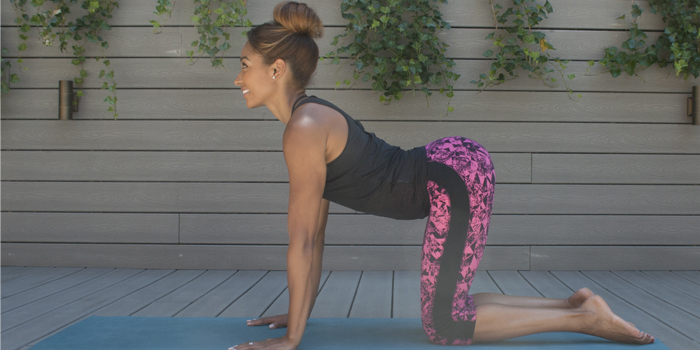The nine months of pregnancy are some of the most beautiful and terrifying times of a woman’s life. During each trimester, you felt your body and emotions shift out of your control, as you gradually adjusted to the idea of a life forming beneath the soft, delicate layers of skin (as if morning sickness didn’t act as a constant violent reminder). But eventually the morning sickness subsided (hopefully!) and you could relish in the gentle bliss, exhibiting the heavenly glow of motherhood.
During those nine months of pregnancy, you saw your body grow, change and evolve into one that may no longer feel like your own. But it’s not just a journey of physical transformations, but emotional and mental as well. As you look at the reflection of your new post-pregnancy body, remind yourself that this beautiful new body housed a human being that you now get to wake up next to every morning.
READ MORE: Women’s Health Cover Girl Rachel Nicks Spills Her Beauty Secrets
As a doula and certified prenatal and postpartum fitness instructor, Rachel Nicks understands the urge to compare yourself to your pre-baby body or celebrities’ post-pregnancy pictures (remember: having a trainer and dietitian at one’s fingertips isn’t exactly “real life”) and rush back into a workout plan. But it’s essential for you to be kind to yourself and your body during the healing process.
She suggests surrounding yourself with other new moms who understand your journey. “Remember that this is a new you, so don’t compare yourself to others or your old body,” she says, explaining that “every woman has 3 body types: Pre-body, pregnancy body and post-body. Own your new body. You’re a real woman now. Embrace it!”
Nicks shared her custom postpartum routine with us, which will help you strengthen the areas weakened during pregnancy in the safest and most effective way!
READ MORE: This Mom’s “Perfect Body” Selfie Inspired Over 125,000 People
1Week 1-6: Rest and Recover
In these first six weeks after your pregnancy, the key to getting in shape is rest. Give your body time to heal and recover. Nicks recommends taking light walks in nature with your baby and doing low impact exercises, like kegels, to engage and strengthen your pelvic floor.
“It’s completely normal to experience some incontinence postpartum, even if you’ve had a cesarean,” Rachel explains, “Your baby has been sitting on your pelvic floor for almost a year before passing through, so it’s important to really focusing your attention on strengthening your pelvic floor.”
2Kegels in Kneeling/Virasana
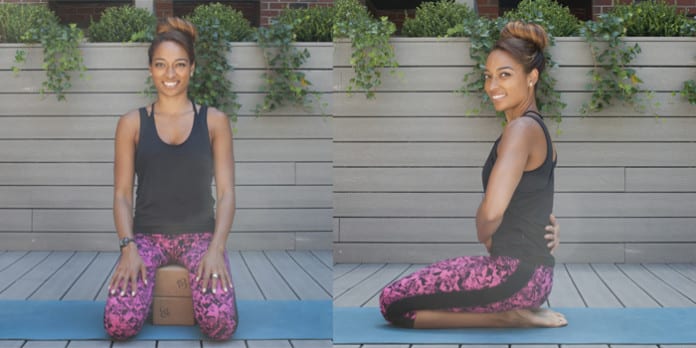
Inhale, release and relax your pelvic and abdominal muscles. Exhale, draw pelvic muscle up and transverse abdominis muscle (aka corset muscle, which runs horizontally across the abdomen) in toward belly button.
Exercise can be done with or without the block, as well as in Child’s Pose as seen above. Hold for a count of five and repeat 10 times. Gradually increase holding time by increments of five as strength grows.
READ MORE: A Girl’s Guide To Kegel Exercises
3After 6 Weeks: Chest Openers
At this point the red sea has finally parted and you can begin easing back into a consistent fitness routine. But keep in mind that although the bleeding has subsided, your body is not fully recovered yet. As you gain more strength, Rachel recommends sticking to low impact workouts, such as barre or yoga.
Rachel also emphasizes the importance of stretching. “You’re constantly hunched over your baby, feeding, changing diapers, and admiring their perfection.” She says, “As a result, your shoulders get really tight, causing tension and pain in your back.”
4Cat/Cow Position
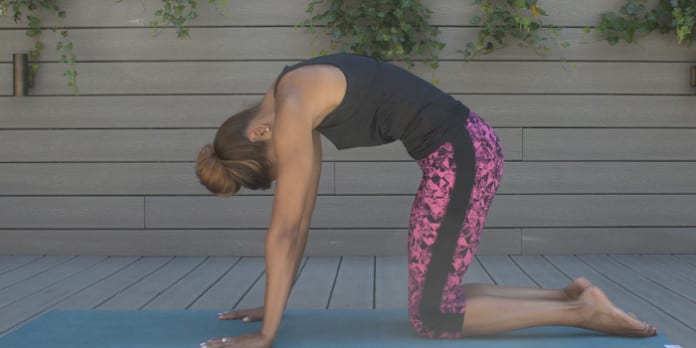
Get on all fours, tuck chin down, arch back, pull stomach towards the back of spine, engaging pelvic muscles. Inhale, allowing breath to spread shoulder blades apart and open up back. Slowly flow into cow.
As you come into cow position, continue to engage pelvic and abdominal muscles. Roll shoulders back and down, opening up the chest and creating a nice stretch in back.
5Arm Extensions
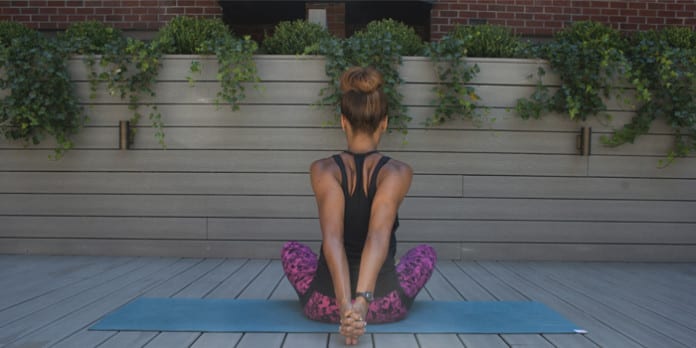
Sit cross-legged and clasp hands behind back, arms extended, thumbs pointing toward the floor. Pull shoulder blades towards each other, lengthen spine, and open your chest. Engage abdominal and pelvic muscles.
READ MORE: Kundalini Yoga Poses 101
6Seated Reverse Prayer
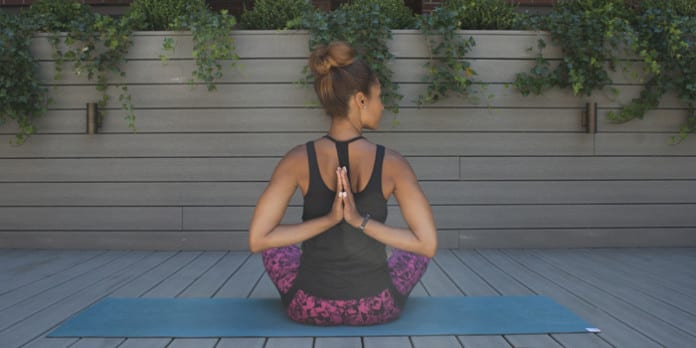
As flexibility increases, work into reverse prayer. Press palms together behind back, roll shoulders back and down, opening the chest, and pushing elbows towards each other. Arms stay active. Engage core and pelvic floor.
7Gomukasana (Cow Arms)
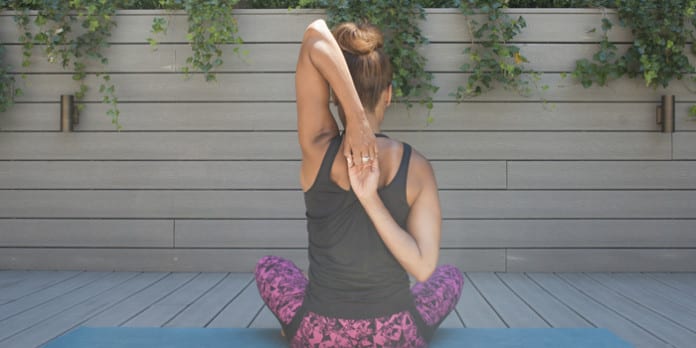
Engage pelvic floor and abdominal muscles, bring one arm up, bend it back behind head, reach opposite arm behind back and up, hands interlock between shoulder blades. Keep spine long, eyes on the horizon. Make sure elbow is pointing toward sky directly above shoulder (don’t hyper-extend).
Variation:
If flexibility is limited, don’t worry! Warm up your muscles by doing an overhead tricep stretch. Simply extend one arm up past head and bend it back, bicep and forearm should touch. Reach over with opposite arm, place hand on elbow and gently pull elbow in the direction of opposite arm.
8Garudasana (Eagle Arms)
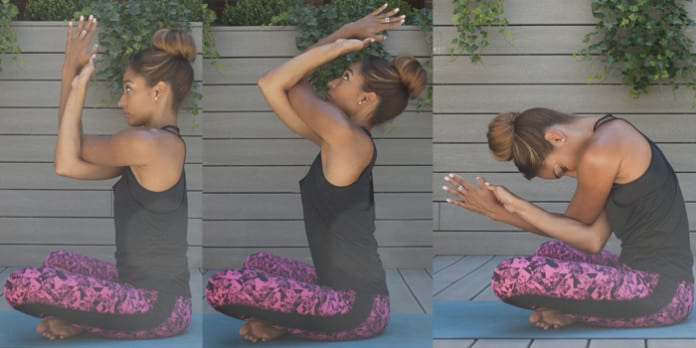
Lift arms in front of you, bending at the elbow. Cross one elbow over the other, slide palms together. Sit tall, engage core and pelvic floor, pull arms forward and away from chest. Really focus attention on opening up the shoulder blades and back, inhaling, as you extend arms up, and exhaling as you bow forward.
9After 6 Weeks: Thigh Work
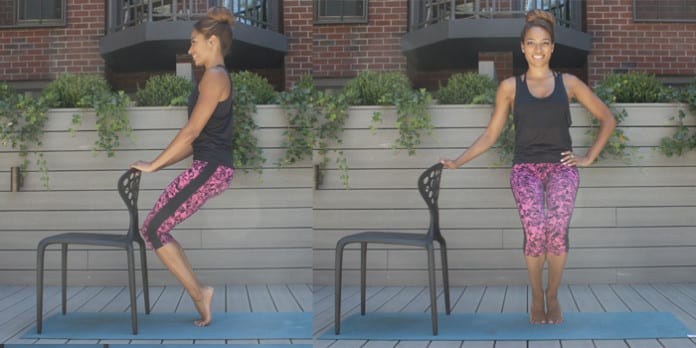
Parallel Thigh
Using a chair for stability, stand in mountain pose and face the chair. Bend knees and lift onto toes. Keep hips tucked under, keeping spine straight. Maintain a straight back as you slowly lower into a squat position. Work in a small range, starting with pulses and increase to full movement as you gain strength.
10Narrow V
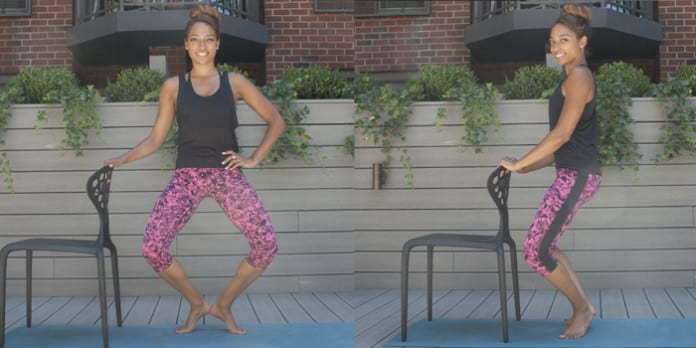
This move is similar to the Parallel V exercise. Start in the same position, then open up stance; hips stacked beneath shoulders, knees pointing out, ankles touching, forming a diamond. Again, gradually work into full range of motion, starting with pulses to warm up muscles.
Keep your core and pelvic muscles engaged throughout movement. Be sure to keep your hips tucked, so your back does not arch.
11Split Lunge
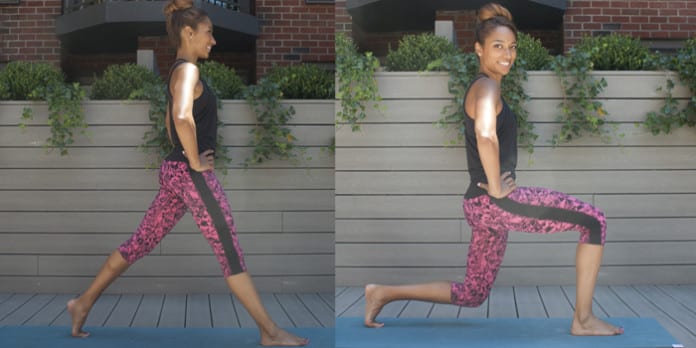
Start out in a long stride; right foot forward, left leg back, hands placed on hips. Keep back straight, slowly lower into a lunge. Let back leg dictate movement. Both legs make a 90 degree angle, left hip over knee, right knee over ankle. Be sure to keep pelvic and abdominal muscles engaged throughout movement. Repeat movement 10 times.
12After 6 Weeks: Core Conditioning
When it comes to your stomach, patience is key. You’ve been carrying precious cargo inside your womb for the past 40 weeks! “If you’re breast feeding, you’re body will maintain an extra 10 pounds due to milk production.” says Rachel, “It’s literally fat storage and typically stores in the mid-section. It can take up to six months to go away, so be patient with your new body.”
READ MORE: How to Change Your Beauty Routine During Pregnancy
Strengthening your core with toning exercises is completely fine, but if you gave birth naturally or even in some cesarian cases, you may have diastasis recti (which is when the rectus abdominus separates). It’s important to avoid forward flexion, like sit-ups and crunches, as these can worsen separation. Stick to exercises like planks and variations, which strengthen the transverse abdominis muscle and draw abs back together.
13Planks
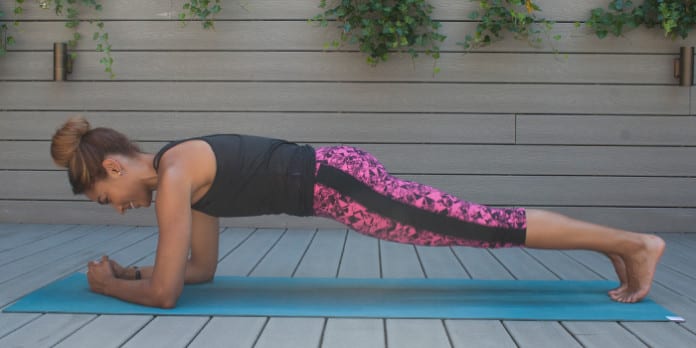
Come down to all fours and extend legs back. Draw belly button in towards spine, exhaling as you squeeze glutes and engage pelvic floor. Hips should be inline with shoulders. Keep back straight. Hold for 10, then 20. Gradually increase increments of 10.
READ MORE: 7 Secrets For A Great First Yoga Class
14Table Top With Opposite Arm And Leg Extension
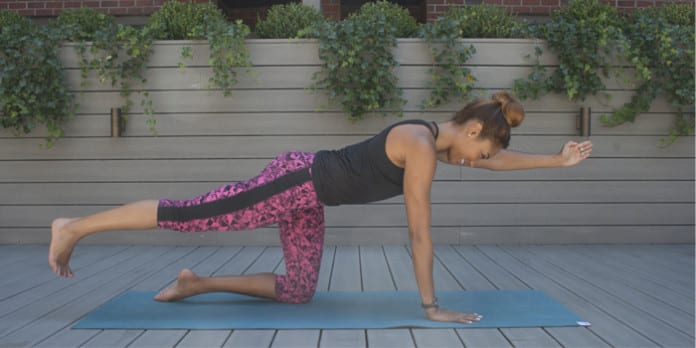
Start on all fours. Slowly extend one leg back, raising it in unison with opposing arm. Squeeze glutes as you lift leg up, hold for a count of 10. Keep core and pelvic floor engaged throughout movement. Slowly lower down and repeat on opposite side.
READ MORE: Yoga Poses Boost Mood




































